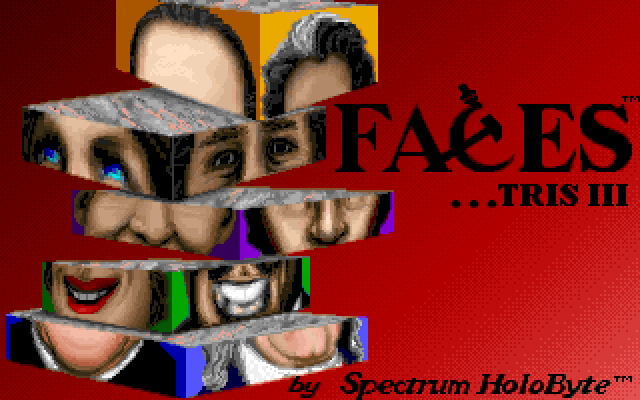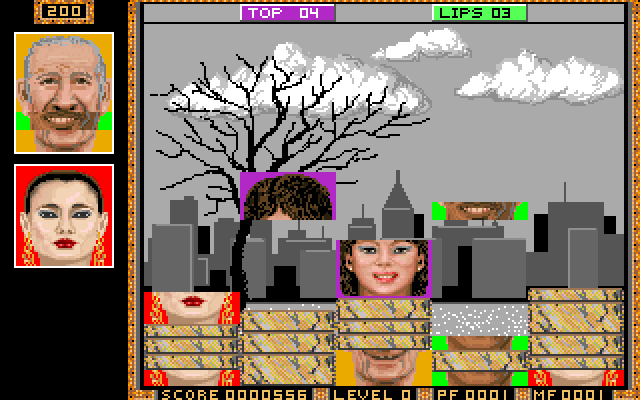Faces …tris III 
After the runaway success of Tetris, the game’s designer Alexey Pajtinov made a few sequels.
First, there was Welltris, a three-dimensional variation of Tetris.
And then… there was Faces, a game where you make faces.
Technically, it’s called Faces …tris III, with the “tris” unconfidently tacked on the end as a reminder that this is actually supposed to be a sequel to Tetris. In reality, the two games have very little in common.
The goal of the game is to assemble a face by stacking body parts as they fall onto the screen. Every face needs a chin, lips, a nose, eyes, and a forehead, in that order. That’s more difficult than it sounds. The pieces come down in pairs, and they have to be stacked in that specific order, which leaves only a thin margin for error and even less room for creativity. If you mess up in a game like Tetris, it creates an opportunity for you to build on your mistakes and eventually recover. When you make a wrong move in Faces, however, you’ve gotta start all over with a new chin. It leaves behind much more of a mess than Tetris does.
Despite being strict and cluttered, it does let you play around with the faces. The falling blocks represent a variety of races and genders, and you can mix and match parts from different people’s faces, like using one person’s nose and another person’s eyes, as long as you can put one whole face together. A face is a face, and that’s what counts.
It feels like this was meant to be a statement about how we’re all part of the same human family. Faces was released in 1990 at the tail end of the Cold War, as the Soviet Union was being dismantled and the future seemed to point to an increasingly open world. Pajitnov himself, a Russian citizen, had begun visiting the United States, eventually moving there the following year. So in the same way that Tetris went all-in on the Soviet theme, Faces feels like it was inspired by everything happening in the world – a more cosmopolitan puzzle game celebrating our global diversity and history. But the mixed-up faces just look kind of terrifying. They have a vague body horror aesthetic that’s less playful than it is like Frankenstein.
The “faces” theme gets weirder and funnier with each passing level. There’s faces of world leaders including Gorbachev and Margaret Thatcher. Or famous authors. Or American historical figures! Or holiday mascots like Santa Claus! Even monsters! Like Dracula and Medusa! Complete with a graveyard in the background and a music track that sounds like the theme from Tales of the Crypt. At least those faces are actually meant to look like Frankenstein!
It’s incredible to witness such a bizarre mistake of a game, especially from a notable designer like Alexey Pajitnov, who seems to have avoided this being a blotch on his resumé. It’s so much stranger that this is, officially, a sequel to one of the most beloved and popular games ever made.
The reason Faces got made at all was because of Pajitnov’s stature in the world of designing puzzle games. Tetris was such a big deal that other game developers seem to have been eager to work with him on whatever ideas he had next, in the hopes that he’d come up with the next Tetris. And in turn, Pajitnov must have felt pressure to repeat his earlier success with a new concept. Along with Welltris, it was the start of a symbiotic relationship between Pajitnov and publisher Spectrum Holobyte, for whom he continued producing and endorsing puzzle games for about half a decade.
As glad I am that this singularly bizarre game exists – and as terrific as it is that this is how Pajitnov decided to capitalize on his fame – I also can’t help but wonder about what new developers had their ideas passed over in favor of bringing this weirdass follow-up to Tetris into the world instead.


